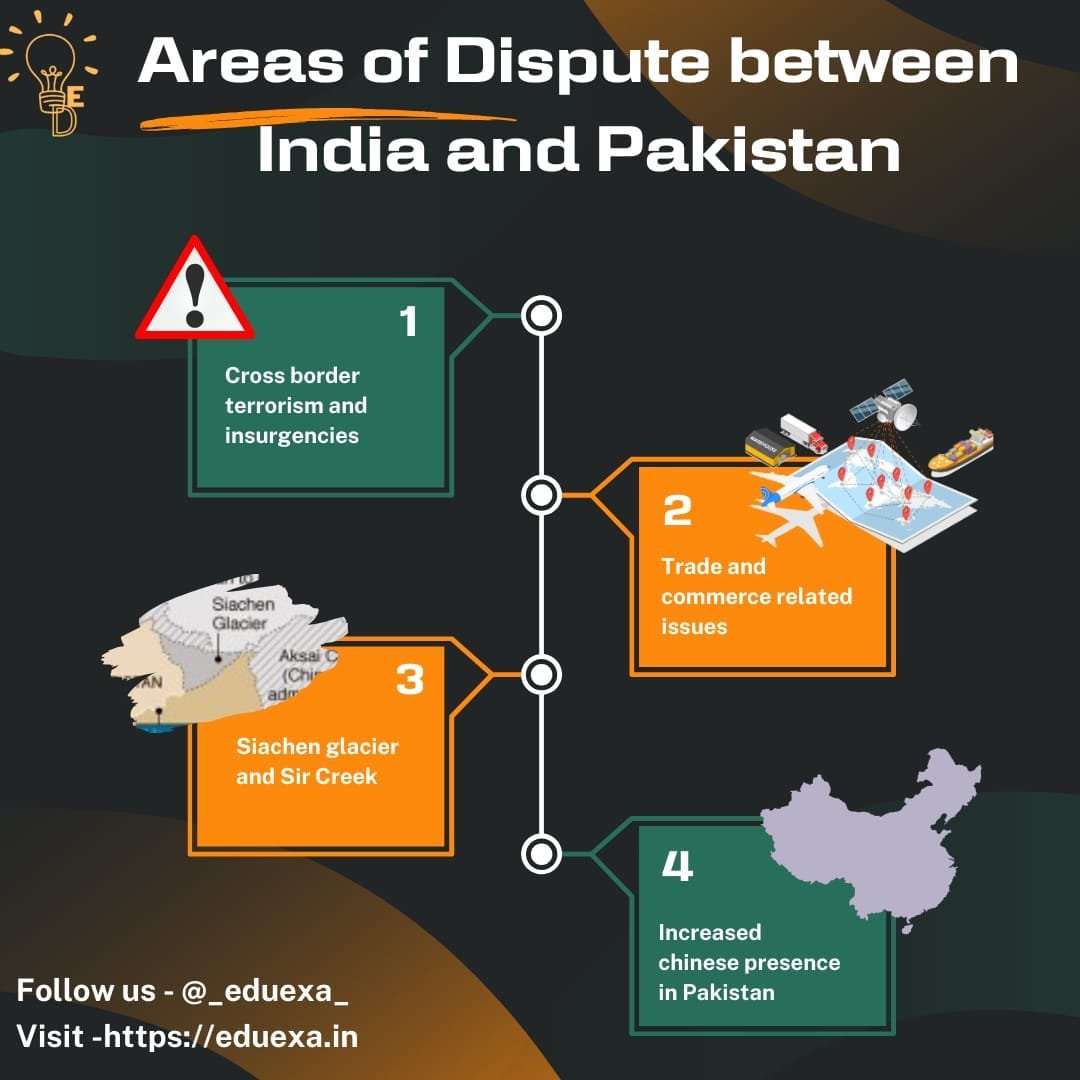Areas of conflict between India and Pakistan
Cross border terrorism
Terrorist activities and insurgencies in bordering areas especially Kashmir has been a regular activity since independence.
Pak sponsored terrorism is based on the military doctrine of ‘Bleeding India with a 1000 cuts’ India has been asking Pakistan to take credible verifiable and irreversible actions against terrorist networks and bring perpetrators of 26/11 Mumbai and 2016 Pathan Rot attack to justice.
India has also joined various international forums to combat terrorism and also has comprehensive laws against the same.
Trade and commerce Issues
Majority of trade between India and Pak is conducted by
=> Sea Route – Mumbai to Karachi
=> Land Route via wagah border through hucks
Reasons for low economic engagement
- Geo-political issue / tensions
- High tariff and non tariff barriers
- SAARC being disfunctional.
- Stalled regional collaboration
- Sense of insecurity.
- Failure of military and non military confidence building measures
In 2019 after Pulwana attack, India hiked custom duty on Pakistan imports to 200% and revoked MFN status from Pakistan.
Pakistan also suspended trade with India on August 2019.
Pakistan PM Shebaz sharif emphasised normalising Indo-Pak relations including trade. However Pak’s attempt to send bilateral trade has many times been stumped by domestic politics and revisionist policies.
Water Dispute
Indus water treaty was signed to divide the 6 rivers between India and Pakistan to have fair share of water resources to both. Despite IWT being uninterrupted and uninterruptible treaty, there’s been continuous trust defecit among the countries.
Pakistan doesn’t allow hydroelectric dams to constructed on jhelum or chenab sensing a risk of water being used for consumption whereas India strongly commits the project as Run of river projects. Ex- Kishenganga dam
Kashmir issue
Dilution of Article 370 as far as foreign policy is concerned could be considered as a master stroke. It will have a short term effect in the sense that it has reaffirmed india’ claim on Jammu and Kashmir and all Indian laws are applicable to it. The long term effect is that it has outmanoeuvred Pakistan which has always used Article 370 To wage a proxy war in Kashmir, internationalise kashmir issue and create disturbances.
Siachen glacier
It is the area northeast of point NJ9842, east of karakoram ranges which is beyond the Line of Control. Strategic importance of Siachen. Siachen acts as a geopolitical and geostrategic frontior for India.
It serves as the divide between POK and Aksai Chin area thereby preventing any military linkages by the 2 counties (Pakistan and China) in the area.
It is close to Karakoram pass through which passes the Karakoram highway (the highway is also called friendship highway) connects Gilgit Baltistan area to the xingziang province of china. Siachen also guards important route leading to Leh Ladakh. Stands as a watch tower for India in respect to Gilgit Baltistan region of POK and also helps in keeping a watch on chinese activities in Aksai chin area.
It gives India a location advantage vis-a-vis Pakistan and china.
Arguments in favour of demilitarisation
- Huge loss of lives of personnel engaged because of tough weather situation.
- Economic loss are also huge for maintaining continuous army there.
- Environmental damage – In jan 2018 nearly 130 tonnes of waste was brought down from siachen glacier according to a report.
- Diplomatically speaking, it could be a step of international goodwill for the world to seek.
- Arguments against demilitarisation
- Siachen is part of pre 1948 Jammu and Kashmir
- Human loss has come down due to technical improvements.
- Money cost is involved everywhere, wherever there’s national security threat so it’s better to prevent any future cost to sovereignty.
- Previous Goodwill gestures have not been recognised by Pakistan.
- Having a control over Siachen (highest battlefield) will always be a better option both in times of war and negotiations.
- It could be an insult to our shaheed martyrs who lost their lives guarding Siachen and borders.
Faced with a 2 front threat from Pak and china, demilitarisation at this point is not a workable Idea. Till the time situation improves, andia simply have to kup holding its control on siachen glacier.
Sir Creek
It 96 km stup of water w/w and 2 pak in Rann of kitch Amp-Bossible presence of oil and gas concentration Huge fishing ouso wice (among the largest fishing. grounds in Asia
What is the dispute?
Diverse interpretation of maritime boundary line between kutch and Sindh.
Pakistan claims the entire creek on the basis of bombay govt resolution of 1914 which included the creek as part of sindh.
India claims that boundary lies mid channel as per map drawn in 1925.
India also cites the ‘Thalweg doctrine’ according to which river boundaries between the 2 states may be divided according to thalweg (deepest point) i.e mid channel if water body is navigable.
Chinese Angle
China and Pakistan are known as Iron Brothers.
Involvement of any power with India and Pakistan has been a situation of zero sum game means any the positive gain with either of the country will involve a subsequent loss in the country’s relationship with the other country. China has taken this Zero Sun dynamic to achieve its strategic goals.
China’s interventions with Pakistan
- Proposal of China Pakistan Economic Corridor (CPEC) as part of BRI initiative.
- Financial aid by China to Pakistan
- China continuously blocks India’s proposal to blacklist Pakistan based LeT group.
Conclusion
There is a great need for both the countries to settle their dispute and adopt soft diplomacy for better people to people connect and reducing trust defecit. Further, there’s great need to avoid international interventions and to solve the issues bilaterally only.
How to choose UPSC Optional Subjects? Read complete guide here.
A Complete guide on One Nation One Election.




Pingback: Complete Guide on India Oman Relations UPSC - Eduexa
Pingback: India's Neighbourhood First Policy: A Complete guide in 2024